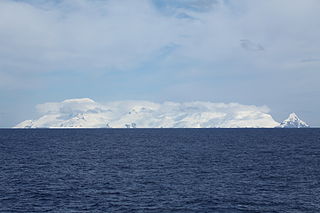
Elephant Island is an ice-covered, mountainous island off the coast of Antarctica in the outer reaches of the South Shetland Islands, in the Southern Ocean. The island is situated 245 kilometres north-northeast of the tip of the Antarctic Peninsula, 1,253 kilometres west-southwest of South Georgia, 935 kilometres south of the Falkland Islands, and 885 kilometres southeast of Cape Horn. It is within the Antarctic claims of Argentina, Chile and the United Kingdom.

Clan Agnew is a Scottish clan from Galloway in the Scottish Lowlands.

Clarence Island is the easternmost island in the South Shetland Islands, off the coast of Antarctica. It is claimed by Argentina as part of Argentine Antarctica, by Britain as part of the British Antarctic Territory, and by Chile as part of the Chilean Antarctic Territory. The name dates back to at least 1820 and is now established in international usage, except for Russia, where it has been known as Shishkova Island since its discovery by the First Russian Antarctic Expedition in 1821.

The Northern Patagonian Ice Field, located in southern Chile, is the smaller of two remnant parts in which the Patagonian Ice Sheet in the Andes Mountains of southern South America can be divided. It is completely contained within the boundaries of Laguna San Rafael National Park.
Sir Crispin Hamlyn Agnew of Lochnaw, 11th Baronet, is a Scottish advocate, herald and former explorer. He is the chief of the ancient Agnew family, and the eleventh holder of the Agnew baronetcy, created in 1629. He was elected a member of the Royal Company of Archers, the King's Body Guard for Scotland in 1975.

Mount Irving is a mountain rising to ca. 1,950 metres (6,398 ft) that is the dominant elevation on Clarence Island, in the South Shetland Islands, Antarctica. The rounded, heavily glaciated mountain is situated in Urda Ridge occupying the southern part of the island. A prominent feature, the mountain doubtless was known to sealers in the area in the 1820s. It was named by United Kingdom Antarctic Place-Names Committee (UK-APC) for Rear Admiral Sir Edmund George Irving, Royal Navy, Hydrographer of the Navy, 1960–66. First ascent by a team comprising Capt. Crispin Agnew, John Hult and Flight Sgt George Bruce BEM, RAF. of the Joint Services Expedition to Elephant Island on 6 December 1970.
Sir Fulque Melville Gerald Noel Agnew, 10th Baronet was the son of Major Charles Hamlyn Agnew and his wife Lillian Anne Wolfe Murray of Cringltie, daughter of General Sir James Wolfe Murray of Cringltie KCB, married on 30 June 1897 but they divorced in 1908.

Lochnaw Castle is a 16th-century tower house five miles from the town of Stranraer, in the historical county of Wigtownshire, Scotland. The central square tower, five storeys high, formed part of the new castle.
Commander Malcolm Keith Burley, (1927–2010) MBE was a British Antarctic explorer, mountaineer and Royal Navy officer. He received the Cuthbert Prize from the Royal Geographical Society.
Leswalt is a village and civil parish in Dumfries and Galloway, south-west Scotland. It lies between Portpatrick and Stranraer in the Rhins of Galloway, part of the traditional county of Wigtownshire. The parish covers around 8 square miles (21 km2).

The British Army Mountaineering Association (AMA) is the governing body for climbing competitions and the representative body for mountaineering in the British Army. It is a member of the British Mountaineering Council and is the largest climbing club in the United Kingdom.

Boyadzhiev Point is the rocky northeast entrance point to Gurkovska Cove on the east coast of Elephant Island in the South Shetland Islands, Antarctica. The area was visited by early 19th century sealers.

Mendoza Cove is the 1.65 km (1.03 mi) wide cove indenting for 680 m (2,230 ft) the south coast of Elephant Island in the South Shetland Islands, Antarctica east of Muckle Bluff. It was formed as a result of the retreat of the island's ice cap in the late 20th century. The area was visited by early 19th century sealers.

Kapka Lake is the 125 m long in southwest–northeast direction and 76 m wide lake on the south coast of Elephant Island in the South Shetland Islands. It has a surface area of 0.32 ha and is separated from the waters of Mendoza Cove by a 20 to 50 m wide strip of land. The area was visited by early 19th century sealers.

Ronalds Point is the rocky point on the north coast of Elephant Island in the South Shetland Islands, Antarctica situated just east of the terminus of Snellius Glacier. The area was visited by early 19th century sealers.

Saffar Island is the rocky island off the north coast of Elephant Island in the South Shetland Islands, Antarctica extending 290 m in west–east direction and 230 m in south–north direction, with a surface area of 3.64 ha. It is separated from Elephant Island by a passage narrowing to 325 m at points.

Biruni Island is the rocky island off the north coast of Elephant Island in the South Shetland Islands, Antarctica 450 m long in southwest–northeast direction and 150 m wide, with a surface area of 3.59 ha. It is separated from Elephant Island by a passage narrowing to 70 m at points. The island was formed as a result of the retreat of Elephant Island's ice cap at the turn of the 21st century.

Eratosthenes Point is the ice-covered, rock-tipped northwest entrance point to Digges Cove on the north coast of Elephant Island in the South Shetland Islands, Antarctica situated just west of the terminus of Snellius Glacier. The area was visited by early 19th century sealers.

Digges Cove is the 1.77 km wide cove indenting for 860 m the north coast of Elephant Island in the South Shetland Islands, Antarctica southeast of Eratosthenes Point. It was formed as a result of the retreat of Snellius Glacier in the late 20th century. The area was visited by early 19th century sealers.

Snellius Glacier is the glacier extending 7 km in west–east direction and 3 km in south–north direction on the north coast of Elephant Island in the South Shetland Islands, Antarctica draining the north slopes of Pardo Ridge and flowing northwards into Drake Passage between Eratosthenes Point and Ronalds Point. The area was visited by early 19th century sealers.









